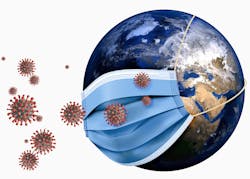New studies report on global surge of BA.2 COVID strain
The UK Health Security Agency (UKHSA) reports that the BA.2 strain is on the increase worldwide, indicating its higher transmissibility and fitness over BA.1.
The difference between the two is in 20 spike mutations. The BA.2 has 28 differences in the spike protein compared to the earlier Delta VOC, 18 being common to BA.1. Many of these are in the N-terminal domain (NTD). Both form syncytia of similar size.
BA.2 is less effectively neutralized by vaccine recipient sera than the wildtype and earlier variants of concern (VOCs) and is less sensitive to a number of neutralizing mAbs.
Most neutralizing antibodies target the receptor-binding domain (RBD) of the viral spike protein. Several combinations of such mAbs are used therapeutically, such as Ronapreve (Imdevimab and Etesivimab) from Regeneron and Evusheld (Cilgavimab and Tixagevimab) from AstraZeneca.
Earlier research showed that the risk of infection was reduced to an eighth with Ronapreve, while symptomatic disease was reduced to the same degree with Evusheld. Both have been approved for emergency use in several countries as pre-exposure prophylaxis (PrEP).
A significant drawback is the failure of these cocktails to neutralize BA.1 completely, with the 50% inhibitory concentration (IC50) of Evusheld increasing by 11-180-fold compared to the wildtype. At the same time, Ronapreve showed no neutralization at all. While this led to the use of the former for PrEP in individuals with weakened immunity, other scientists explored the feasibility of using the pan-coronavirus mAb Sotrovimab in high-risk individuals.
The current study compares the neutralization of BA.1 and BA.2 by nine therapeutic mAbs in cell culture, measuring the neutralizing activity of the serum antibodies against either strain in recipients of either Ronapreve or Evusheld.
What Did the Study Show?
The antibodies tested for BA.2 neutralization included examples from all four classes of anti-RBD antibodies. Etesevimab (class 1) and Bamlanivimab (Class 2) were found in an early cocktail from Eli Lilly but are now obsolete in clinical practice. Regdanvimab (class 1), Sotrovimab and Adintrevimab were also included, apart from the four found in Ronapreve and Evusheld.
Seven of these proved ineffective against BA.2, the exceptions being Imdevimab and Cilgavimab. The IC50 of these were ~700 and 9 ng/mL, respectively, against BA.2, which is suggestive of better efficacy against this sublineage compared to BA.1. No further enhancement of efficacy was observed with the addition of Tixagevimab, as in Evusheld.
The scientists also found that immunocompromised people, most of whom were on anti-CD20 and prednisone for conditions like rheumatoid arthritis and kidney transplantation, responded well to Evusheld. Of the 29 patients in the study, 18 had been first treated with Ronapreve, and almost all had received three doses of the messenger ribonucleic acid (mRNA) SARS-CoV-2 vaccine BNT162b2 from Pfizer/BioNTech. Six had received four doses.
All received Evusheld PrEP because they had sub-threshold binding antibody levels after vaccination. Anti-spike immunoglobulin G (IgG) levels spiked from 5-60 binding antibody unit (BAU)/mL before treatment to 200-1300 BAU/mL afterward. Notably, those who had Ronapreve previously had anti-spike antibodies at ~800-1,000 BAU/mL when Evusheld was administered and showed no obvious response.
